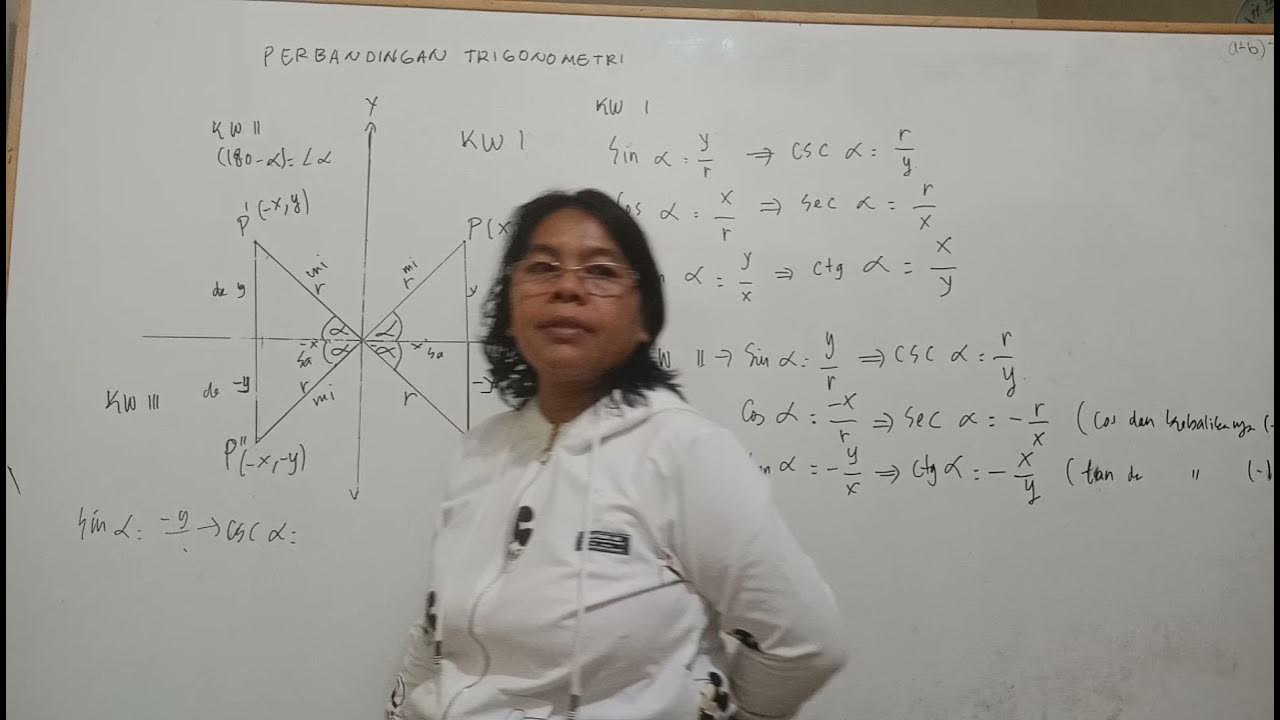Part 2-Rumus Cosinus Jumlah dan Selisih Dua Sudut
Summary
TLDRIn this educational video, Asma Rahmat from Kuromet Channel explains the trigonometric formulas for the sum and difference of two angles, specifically focusing on cosine. The video delves into deriving these formulas using properties of angles and relational identities. Through step-by-step examples, the video demonstrates how to calculate the values of cosine for non-special angles, such as 105° and 15°, without the use of calculators or trigonometric tables. Additionally, the video tackles various problems, including practical applications and solutions using the derived formulas for cosine of sum and difference of angles.
Takeaways
- 😀 The video covers the derivation of the cosine sum and difference identities, focusing on cos(α + β) and cos(α - β).
- 😀 The sine sum and difference formulas are used as the foundation for deriving the cosine identities.
- 😀 Key angle relationships like cos(90° - x) = sin(x) and sin(90° - x) = cos(x) are applied to simplify the process.
- 😀 The derived formula for cos(α + β) is: cos(α + β) = cos(α)cos(β) - sin(α)sin(β).
- 😀 The formula for cos(α - β) is derived as: cos(α - β) = cos(α)cos(β) + sin(α)sin(β).
- 😀 The video provides step-by-step examples of using these formulas to compute specific cosine values.
- 😀 Example 1 involves calculating cos(105°) by expressing it as the sum of 60° and 45°, and applying the sum formula.
- 😀 Example 2 demonstrates calculating cos(15°) by expressing it as the difference of 45° and 30°, using the difference formula.
- 😀 In the second example, the result for cos(15°) is simplified to: (1/4)(√6 + √2).
- 😀 The video shows how to solve problems without using calculators by breaking angles into known special angles and applying the trigonometric identities.
- 😀 The video also includes examples with specific cosine values (e.g., cos(α) = 3/5, cos(β) = 12/13) and demonstrates how to use these to find cos(α + β).
Q & A
What is the main topic discussed in the video?
-The main topic discussed in the video is the trigonometric formulas for the sum and difference of two angles, specifically focusing on the cosine formulas for addition and subtraction.
What trigonometric identity is used to derive the cosine addition formula?
-The identity used to derive the cosine addition formula is the sine difference identity, along with certain angle relationships like cos(90° - x) = sin(x) and sin(90° - x) = cos(x).
How is the cosine of the sum of two angles (cos(α + β)) derived in the video?
-The cosine of the sum of two angles, cos(α + β), is derived by using the sine difference identity, converting cos(α + β) into a sine function, and simplifying it using angle properties and trigonometric identities.
What is the formula for cos(α + β) derived in the video?
-The formula derived for cos(α + β) is cos(α + β) = cos(α)cos(β) - sin(α)sin(β).
How is the cosine of the difference of two angles (cos(α - β)) derived?
-The cosine of the difference of two angles, cos(α - β), is derived by using the sum of angles formula. By substituting -β for the second angle, the identity cos(α - β) = cos(α)cos(β) + sin(α)sin(β) is obtained.
What key property of angles is used in deriving the cosine difference formula?
-A key property used in deriving the cosine difference formula is that sin(-x) = -sin(x) and cos(-x) = cos(x), which allows for simplification when dealing with negative angles.
What is the first example problem presented in the video about cos(105°)?
-The first example problem involves calculating cos(105°). It is rewritten as cos(60° + 45°) and solved using the cosine sum formula, resulting in a value of 1/4(√2 - √6).
How is cos(15°) calculated in the video?
-Cos(15°) is calculated by expressing it as cos(45° - 30°) and applying the cosine difference formula, leading to the simplified result of 1/4(√6 + √2).
What is the second example problem about cos(α + β) where cos(α) = 3/5 and cos(β) = 12/13?
-In the second example, given cos(α) = 3/5 and cos(β) = 12/13, the goal is to find cos(α + β). This is done by calculating sin(α) and sin(β) using the Pythagorean theorem and substituting the values into the cosine sum formula to find the answer.
What method is used to solve for cos(α + β) in the second example?
-The method used involves constructing right triangles for both angles α and β based on their given cosines, calculating the corresponding sines, and applying these values in the cosine addition formula to find cos(α + β).
Outlines

This section is available to paid users only. Please upgrade to access this part.
Upgrade NowMindmap

This section is available to paid users only. Please upgrade to access this part.
Upgrade NowKeywords

This section is available to paid users only. Please upgrade to access this part.
Upgrade NowHighlights

This section is available to paid users only. Please upgrade to access this part.
Upgrade NowTranscripts

This section is available to paid users only. Please upgrade to access this part.
Upgrade NowBrowse More Related Video

Identidades trigonométricas, Identidades de simetría e identidades de suma y resta.

Perbandingan Trigonometri

Jumlah dan selisih dua sudut trigonometri matematika kelas XI

TRIGONOMETRÍA: Cos (a+b) Demostración de la fórmula Academia DIEGO

Sum and Difference Identities & Formulas - Sine, Cosine, Tangent - Degrees & Radians, Trigonometry

10 класс. Алгебра. Тригонометрические уравнения, решаемые разложением левой части на множители
5.0 / 5 (0 votes)